The first part of our tutorial focuses of formatting dates in Excel and explains how to set the default date and time formats, how to change date format in Excel, how to create custom date formatting, and convert your dates to another locale.
Along with numbers, dates and times are the most common data types people use in Excel. However, they may be quite confusing to work with, firstly, because the same date can be displayed in Excel in a variety of ways, and secondly, because Excel always internally stores dates in the same format regardless of how you have formatted a date in a given cell.
Knowing the Excel date formats a little in depth can help you save a ton of your time. And this is exactly the aim of our comprehensive tutorial to working with dates in Excel. In the first part, we will be focusing on the following features:
Excel date format
Before you can take advantage of powerful Excel date features, you have to understand how Microsoft Excel stores dates and times, because this is the main source of confusion. While you would expect Excel to remember the day, month and the year for a date, that's not how it works...
Excel stores dates as sequential numbers and it is only a cell's formatting that causes a number to be displayed as a date, time, or date and time.
Dates in Excel
All dates are stored as integers representing the number of days since January 1, 1900, which is stored as number 1, to December 31, 9999 stored as 2958465.
In this system:
- 2 is 2-Jan-1900
- 3 is 3-Jan-1900
- 42005 is 1-Jan-2015 (because it is 42,005 days after January 1, 1900)
Time in Excel
Times are stored in Excel as decimals, between .0 and .99999, that represent a proportion of the day where .0 is 00:00:00 and .99999 is 23:59:59.
For example:
- 0.25 is 06:00 AM
- 0.5 is 12:00 PM
- 0.541655093 is 12:59:59 PM
Dates & Times in Excel
Excel stores dates and times as decimal numbers comprised of an integer representing the date and a decimal portion representing the time.
For example:
- 1.25 is January 1, 1900 6:00 AM
- 42005.5 is January 1, 2015 12:00 PM
How to convert date to number in Excel
If you want to know what serial number represents a certain date or time displayed in a cell, you can do this in two ways.
1. Format Cells dialog
Select the cell with a date in Excel, press Ctrl+1 to open the Format Cells window and switch to the General tab.
If you just want to know the serial number behind the date, without actually converting date to number, write down the number you see under Sample and click Cancel to close the window. If you want to replace the date with the number in a cell, click OK.
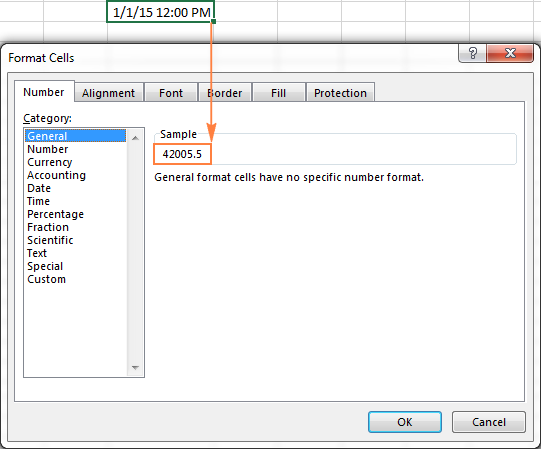
2. Excel DATEVALUE and TIMEVALUE functions
Use the DATEVALUE() function to convert an Excel date to a serial number, for example =DATEVALUE("1/1/2015").
Use the TIMEVALUE() function to get the decimal number representing the time, for example =TIMEVALUE("6:30 AM").
To know both, date and time, concatenate these two functions in the following way:
=DATEVALUE("1/1/2015") & TIMEVALUE("6:00 AM")

Note. Since Excel's serial numbers begins on January 1, 1900 and negative numbers aren't recognized, dates prior to the year 1900 are not supported in Excel.
If you enter such a date in a sheet, say 12/31/1899, it will be a text value rather than a date, meaning that you cannot perform usual date arithmetic on early dates. To make sure, you can type the formula =DATEVALUE("12/31/1899") in some cell, and you will get an anticipated result - the #VALUE! error.
If you are dealing with date and time values and you'd like to convert time to decimal number, please check out the formulas described in this tutorial: How to convert time to decimal number in Excel.
Default date format in Excel
When you work with dates in Excel, the short and long date formats are retrieved from your Windows Regional settings. These default formats are marked with an asterisk (*) in the Format Cell dialog window:
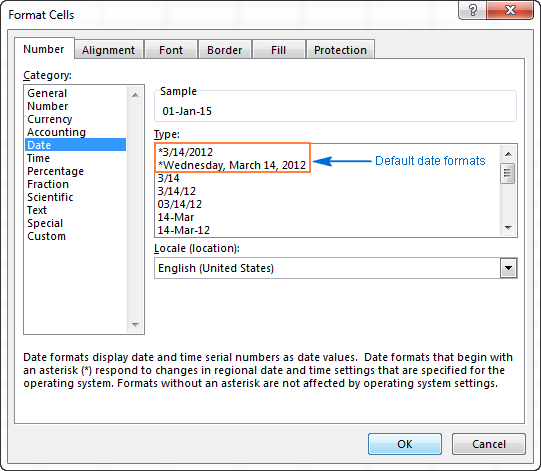
The default date and time formats in the Format Cell box change as soon as you change the date and time settings in Control Panel, which leads us right to the next section.
How to change the default date and time formats in Excel
If you want to set a different default date and/or time formats on your computer, for example change the USA date format to the UK style, go to Control panel and click Region and Language. If in your Control panel opens in Category view, then click Clock, Language, and Region > Region and Language > Change the date, time, or number format.
On the Formats tab, choose the region under Format, and then set the date and time formatting by clicking on an arrow next to the format you want to change and selecting the desired one from the drop-down list:
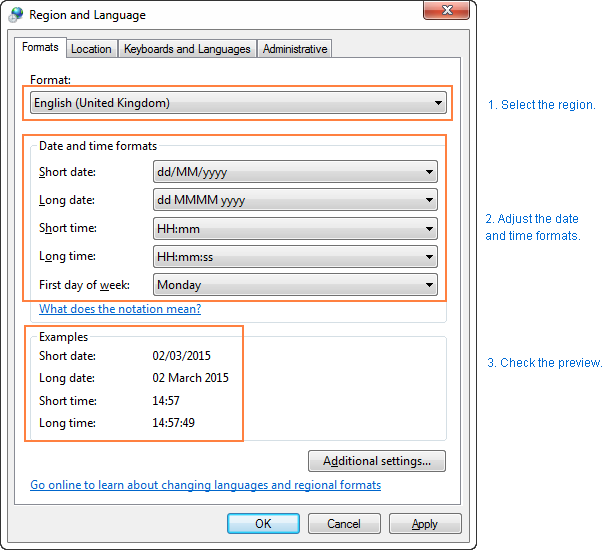
Tip. If you are not sure what different codes (such as mmm, ddd, yyy) mean, click the "What does the notation mean" link under the Date and time formats section, or check the Custom Excel date formats in this tutorial.
If you are not happy with any time and date format available on the Formats tab, click the Additional settings button in the lower right-hand side of the Region and Language dialog window. This will open the Customize dialog, where you switch to the Date tab and enter a custom short or/and long date format in the corresponding box.
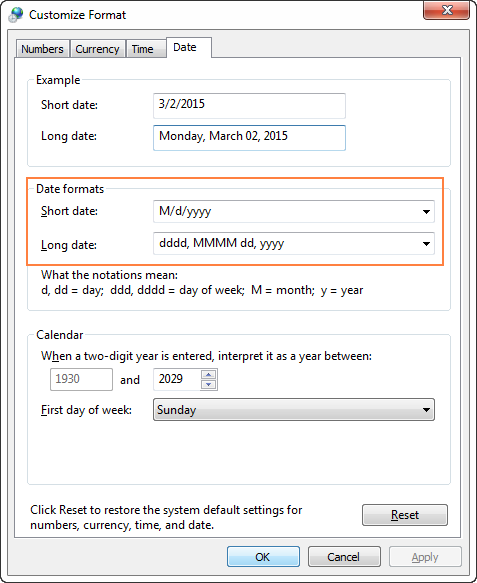
How to quickly apply default date and time formatting in Excel
Microsoft Excel has two default formats for dates and time - short and long, as explained in default Excel date format.
To quickly change date format in Excel to the default formatting, do the following:
- Select the dates you want to format.
- On the Home tab, in the Number group, click the little arrow next to the Number Format box, and select the desired format - short date, long date or time.
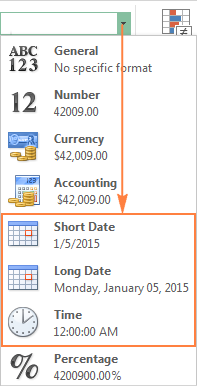
If you want more date formatting options, either select More Number Formats from the drop-down list or click the Dialog Box Launcher next to Number. This will open a familiar Format Cells dialog and you can change date format there.
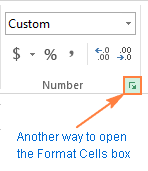
Tip. If you want to quickly set date format in Excel to dd-mmm-yy, press Ctrl+Shift+#. Just keep in mind that this shortcut always applies the dd-mmm-yy format, like 01-Jan-15, regardless of your Windows Region settings.
How to change date format in Excel
In Microsoft Excel, dates can be displayed in a variety of ways. When it comes to changing date format of a given cell or range of cells, the easiest way is to open the Format Cells dialog and choose one of the predefined formats.
- Select the dates whose format your want to change, or empty cells where you want to insert dates.
- Press Ctrl+1 to open the Format Cells dialog. Alternatively, you can right click the selected cells and choose Format Cells… from the context menu.
- In the Format Cells window, switch to the Number tab, and select Date in the Category list.
- Under Type, pick a desired date format. Once you do this, the Sample box will display the format preview with the first date in your selected data.
- If you are happy for the preview, click the OK button to save the format change and close the window.
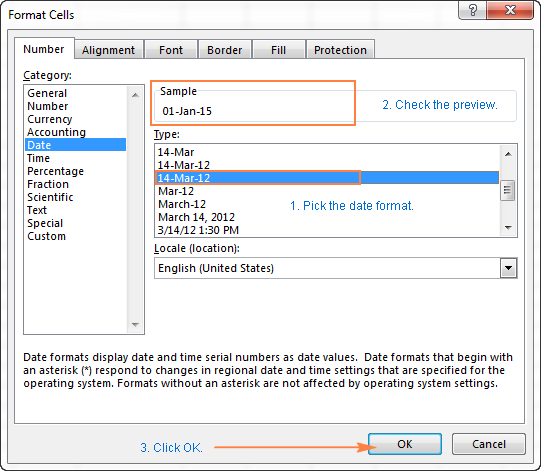
If the date format is not changing in your Excel sheet, most likely your dates are formatted as text and you have to convert them to the date format first.
How to convert date format to another locale
Once you've got a file full of foreign dates and you would most likely want to change them to the date format used in your part of the world. Let's say, you want to convert an American date format (month/day/year) to a European style format (day/month/year).
The easiest way to change date format in Excel based on how another language displays dates is as follows:
- Select the column of dates you want to convert to another locale.
- Press Ctrl+1 to open the Format Cells
- Select the language you want under Locale (location) and click OK to save the change.
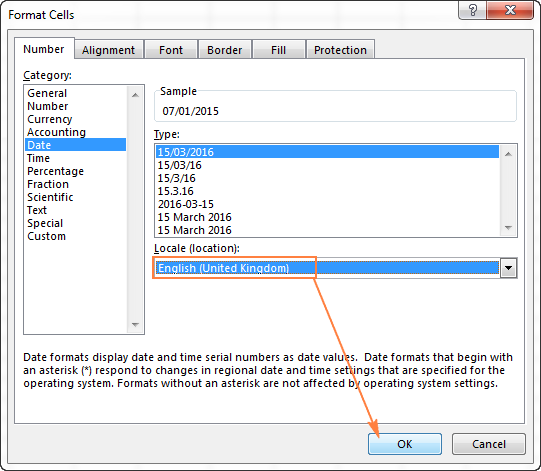
If you want the dates to be displayed in another language, then you will have to create a custom date format with a locale code.
Creating a custom date format in Excel
If none of the predefined Excel date formats is suitable for you, you are free to create your own.
- In an Excel sheet, select the cells you want to format.
- Press Ctrl+1 to open the Format Cells dialog.
- On the Number tab, select Custom from the Category list and type the date format you want in the Type box.
- Click OK to save the changes.
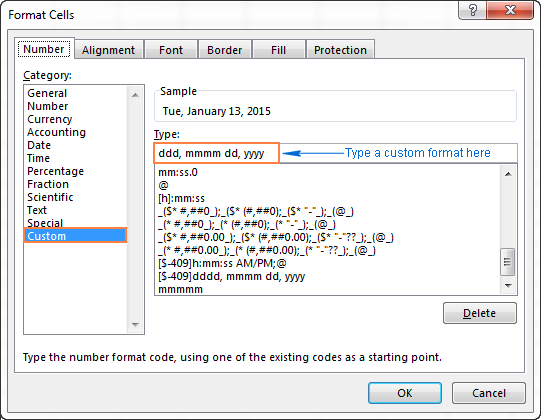
Tip. The easiest way to set a custom date format in Excel is to start from an existing format close to what you want. To do this, click Date in the Category list first, and select one of existing formats under Type. After that click Custom and make changes to the format displayed in the Type box.
When setting up a custom date format in Excel, you can use the following codes.
| Code | Description | Example (January 1, 2005) |
| m | Month number without a leading zero | 1 |
| mm | Month number with a leading zero | 01 |
| mmm | Month name, short form | Jan |
| mmmm | Month name, full form | January |
| mmmmm | Month as the first letter | J (stands for January, June and July) |
| d | Day number without a leading zero | 1 |
| dd | Day number with a leading zero | 01 |
| ddd | Day of the week, short form | Mon |
| dddd | Day of the week, full form | Monday |
| yy | Year (last 2 digits) | 05 |
| yyyy | Year (4 digits) | 2005 |
When setting up a custom time format in Excel, you can use the following codes.
| Code | Description | Displays as |
| h | Hours without a leading zero | 0-23 |
| hh | Hours with a leading zero | 00-23 |
| m | Minutes without a leading zero | 0-59 |
| mm | Minutes with a leading zero | 00-59 |
| s | Seconds without a leading zero | 0-59 |
| ss | Seconds with a leading zero | 00-59 |
| AM/PM | Periods of the day (if omitted, 24-hour time format is used) |
AM or PM |
To set up date and time format, include both date and time units in your format code, e.g. m/d/yyyy h:mm AM/PM. When you use "m" immediately after "hh" or "h" or immediately before "ss" or "s", Excel will display minutes, not a month.
When creating a custom date format in Excel, you can use a comma (,) dash (-), slash (/), colon (:) and other characters.
For example, the same date and time, say January 13, 2015 13:03, can be displayed in a various ways:
| Format | Displays as |
| dd-mmm-yy | 13-Jan-15 |
| mm/dd/yyyy | 01/13/2015 |
| m/dd/yy | 1/13/15 |
| dddd, m/d/yy h:mm AM/PM | Tuesday, 1/13/15 1:03 PM |
| ddd, mmmm dd, yyyy hh:mm:ss | Tue, January 13, 2015 13:03:00 |
Tip. Using a custom date format, you can easily display the day of the week from date.
How to create a custom Excel date format for another locale
If you want to display dates in another language, you have to create a custom format and prefix a date with a corresponding locale code. The locale code should be enclosed in [square brackets] and preceded with the dollar sign ($) and a dash (-). Here are a few examples:
- [$-409] - English, Untitled States
- [$-1009] - English, Canada
- [$-407] - German, Germany
- [$-807] - German, Switzerland
- [$-804] - Bengali, India
- [$-804] - Chinese, China
- [$-404] - Chinese, Taiwan
You can find the full list of locale codes on this blog.
For example, this is how you set up a custom Excel date format for the Chinese locale in the year-month-day (day of the week) time format:
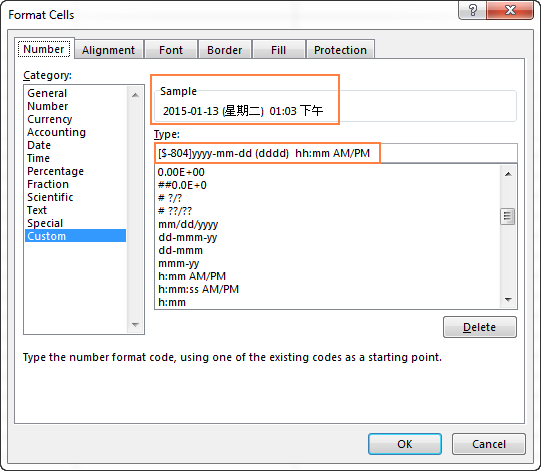
The following image shows a few examples of the same date formatted with different locale codes in the way traditional for the corresponding languages:

Excel date format not working - fixes and solutions
Usually, Microsoft Excel understands dates very well and you are unlikely to hit any roadblock when working with them. If you happen to have an Excel date format problem, please check out the following troubleshooting tips.
A cell is not wide enough to fit an entire date
If you see a number of pound signs (#####) instead of dates in your Excel worksheet, most likely your cells are not wide enough to fit the whole dates.
Solution. Double-click the right border of the column to resize it to auto fit the dates. Alternatively, you can drag the right border to set the column width you want. For more details, see How to fix #### error in Excel.
Negative numbers are formatted as dates
Hash marks (#####) are also displayed when a cell formatted as a date or time contains a negative value. Usually it's a result returned by some formula, but it may also happen when you type a negative value into a cell and then format that cell as a date.
If you want to display negative numbers as negative dates, two options are available to you:
Solution 1. Switch to the 1904 date system.
Go to File > Options > Advanced, scroll down to the When calculating this workbook section, select the Use 1904 date system check box, and click OK.
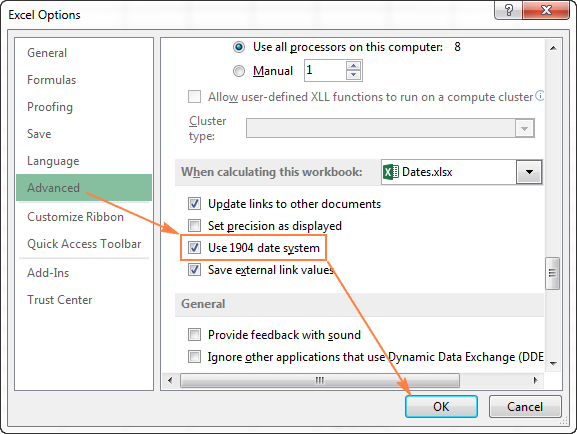
In this system, 0 is 1-Jan-1904; 1 is 2-Jan-1904; and -1 is displayed as a negative date -2-Jan-1904.

Of course, such representation is very unusual and takes time to get used to, but this is the right way to go if you want to perform calculations with early dates.
Solution 2. Use the Excel TEXT function.
Another possible way to display negative numbers as negative dates in Excel is using the TEXT function. For example, if you are subtracting C1 from B1 and a value in C1 is greater than in B1, you can use the following formula to output the result in the date format:
=TEXT(ABS(B1-C1),"-d-mmm-yyyy")
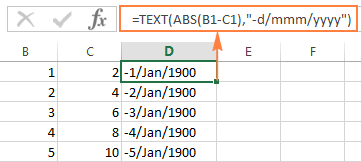
You may want to change the cell alignment to right justified, and naturally, you can use any other custom date formats in the TEXT formula.
Note. Unlike the previous solution, the TEXT function returns a text value, that is why you won't be able to use the result in other calculations.
Dates are imported to Excel as text values
When you are importing data to Excel from a .csv file or some other external database, dates are often imported as text values. They may look like normal dates to you, but Excel perceives them as text and treats accordingly.
Solution. You can convert "text dates" to the date format using Excel's DATEVALUE function or Text to Columns feature. Please see the following article for full details: How to convert text to date in Excel.
Tip. If none of the above tips worked for you, then try to remove all formatting and then set the desired date format.
This is how you format dates in Excel. In the next part of our guide, we will discuss various ways of how you can insert dates and times in your Excel worksheets. Thank you for reading and see you next week!
 by
by
940 comments
Hi,
Through cell custom formatting, how to add (A) to a date to indicate that this date is actual like 05-Jan-24 (A) with out impacting the cell if it's needed in another formula.
Thanks,
MO
Hi!
You can use a custom date format that will not affect the value in the cell. You can find the examples and detailed instructions here: How to change Excel date format and create custom formatting. For example:
dd-mmm-yy (A)
Hi Alexander,
In my budget I have a list of bills that have to be paid each year at different dates when each one is due, I want to be able to change the date and for it to auto moved with its row up, for example, my rates are due 3/8/2024 (dates are in column A, details in B to E) when I alter the date to 3/8/2025 I want it moved along with its row up and sorted by it's new date. Also, can that row on its due date A to E be copped and auto sent to another row further down just below the last entry.
Hope I have made this clear enough, and it would be much appreciate if you could give me a formula to do this from row 3 to 23.
Thank you.
Peter
Hello Peter!
If I understand your question correctly, try to use the recommendations described in this article: How to sort by date in Excel: in chronological order, by month, auto sort.
You can also use the formula and the SORT function as described here: Excel SORT function - automatically sort with formula.
Based on your information, the formula might look something like this:
=SORT(A3:E23,1,-1,FALSE)
Ive got time / date coming in from an external source that looks like this - 2024-11-01T05:32:53.4866667+11:00 and when I paste it into another sell it shows =TEXT(([@[Enter Date]]),"-d/mmm/yyyy")
I dont care about the times, I just need the dates to show so I can sort the numbers by month/week/day of the week. Any help would be appreciated!
Thanks
Hello Mel!
You must extract the date from the text string and convert it to the present date. You can find the examples and detailed instructions here: How to convert text to date and number to date in Excel. Extract the first 10 characters from the text using the LEFT function and use the DATEVALUE function:
=DATEVALUE(LEFT(A1,10))
You can also extract the year, month, and day from text using substring functions and create a date using DATE function. For example:
=DATE(LEFT(A1,4),MID(A1,6,2),MID(A1,9,2))
Hi!
How do I convert to date in the cell? Currently showing as 44835 but date is 01/10/2022.
Date is correc in the formula bar, but in the cell comes up as 44835.
Thanks :)
Kirby
Hi Kirby!
Please re-check the article since it covers your case. Use Format Cells dialog, as described in the article above. Select and set the date format that you want to use in the cell.
Is there a way to make the date format deal with values of zero in a specific way? I'm using a formula to look up dates; it's possible for it to return a value of 0. I don't mind that, but it'd be nice to see it as "0" or "-" instead of "1/1/1900".
Yes, I could play with the formula or use conditional formatting. But I was wondering if there's a way with the date format itself.
Hello Julie!
Here is an example of a custom date format that does not show date if the value is 0.
dd.mm.yyyy;;"-"
For the detailed instructions, please see: Understanding Excel number format.
Great, thanks! I'd tried something similar, but missed that I needed two semicolons.
I have dates in excel which are showing up as #####. I tried your methods of converting it into 1904 method. But it's still the same. These #### show up as numbers but they are dates. How can I convert these #### into dates. for ex. -685608 and -683783 show up as ######## in the column.
Hi! If you used the 1904 date system, negative dates should display correctly. Maybe this article will help: What # sign means in Excel and how to remove #### from cell.
Hi, How can i enter format the cell so that when I enter yyyymmdd (no hyphens or slashes) it comes out at dd-mmm-yy ?
Hello Kram!
If you enter a number without date delimiters in yyyyymmdd format, Excel will identify it as a regular number, not a date. However, you can convert it to a date in a neighboring cell using these guidelines: How to convert text to date and number to date in Excel. For example:
=DATE(RIGHT(A1,4), MID(A1,3,2), LEFT(A1,2))
Then set the desired date format in the formula cell.
You can also use a VBA macro to convert a number to a date in the same cell.
I recommend paying attention to the Text to Date tool. This tool easily converts text strings of different formats to dates.
The tool is included in the Ultimate Suite for Excel and can be used in a free trial to see how it works.
In excel, some of the dates didn't convert properly when the data was saved as a CSV. This issue only occurs on my new laptop; it worked perfectly on my old. one.
My data downloaded from linkedIn has the following format : 05/31/2024, 05/30/2024, etc. The date functions are not working on this column. The steps mentioned above is not working either. How do I convert these values to 31-05-2024, 30-05-2024, etc?
Hi! I'm assuming your dates are written as text. We have a special tutorial on this. Please see How to convert text to date and number to date in Excel.
To create a date, you can use DATE function and extract desired numbers for it from the text using substring functions.
For example:
=DATE(RIGHT(A1,4),LEFT(A1,2),MID(A1,4,2))
In the formula cell, set date format that you want to use.
You can solve the problem without using formulas. I recommend paying attention to the Text to Date tool. This tool easily converts text strings of different formats to dates. The tool is included in the Ultimate Suite for Excel and can be used in a free trial to see how it works.
while i am making a Gantt chart, i am making time as per week wise. up to 9 weeks it came as expected i used custom function to present date as August 23 2024. But after i week of September, instead of September 14 (second week) it is going back to "Jan 14 1990". Every thing is same as previous but why it is coming like this not understanding.
please help in this regard
Thanks in advance for your support
Dr. Sathish
Hi! Unfortunately, this information is insufficient to give advice. Write what custom function you used and how your dates are stored.
January 14, 1990 means the number 14. But I can't guess how you got it.
Hi! I want to write the short form of the month with MMM, but it only shortens some of the months for example Feb but Mars and July remains the same. I only want to visualize the first three letters. How do I fix this?
Hi! I have tried to reproduce your problem. The format "MMM" shows July as "Jul", March as "Mar".
Hello,
How can I have a DOB field show as all ####? I've tried numerous combinations in the custom cell field, but I have not been succesful finding the formula that will display only the hashtag in the sheet without other characters. Thank you.
Hi! Your question is not entirely clear to me. Please clarify your specific problem or provide additional details to highlight exactly what you need.
Hello I need to actually change how the data reads in the cell. I know there is a formula that I can input in the cell next to my date, then copy paste as values for my cells to read my formula out put but I need to convert my date from 04/01/2024 6:34:28 to 2024/04/01. currently all of these options visually change the readout butt hey do not change the data when the cell is clicked on
Hi! If the date and time are written in a cell, you can exclude the time either by copying the result of the formula from another cell or by using VBA macro.
How do I actually change the date stored in the cell, I can visually change the date following the article, but when you click on the cell "stored" is still 4/1/2024 6:38:24 AM I need the cell data to read 2024/04/01 6:38:24 AM
Hi! I don't know what "click on the cell "stored" " means, but read the article above carefully and try, for example, this format: yyyy/mm/dd h:mm:ss AM/PM
Hi I'm facing a strange issue the formatting for dates looks the same but able to convert half of it not the whole table what to do - 01-06-2000. I'm able to convert this to March using this formula=TEXT(A2,"mmmm"). when it comes to this one 1/13/2000 I'm unable to do anything even i tried converting into 1-13-2000 this but nothing work what to do now?
Hi! Check if the value 1/13/2000 matches the date format used in your computer. For example, if you use the date format dd-mm-yyyyy, this value will be written as text. Therefore, you cannot change its format. The following tutorial should help: How to convert text to date in Excel.
Hi. how can i change this date format January 16, 1991 to number like this 11691
Hi! If you had read the recommendations in the article above about changing the date format, you would have found the solution yourself: mddyy
How do I change a date from 11/13/2023 to 11-13-2023?
Please re-check the article above since it covers your task.
I want to have through dates such as 12/1-12/15 display as Dec-1 - Dec. 15. How can I create a custom date format to make this happen?
Hi! If your two dates are written in different cells, you can set the date format for each cell. Your data is text, not a date. Therefore, you cannot format it. If your dates are written in different cells, you can combine them into a text string in the desired format using the TEXT function.
=TEXT(A1,"mmm-d")&" - "&TEXT(A2,"mmm-d")
We have a special tutorial on this. Please see Convert date to text in Excel.
Trying the LEFT, MID function to extract and reformat date from 1961-04-11 to 04/11/1961, but not working. The original date is formatted as text. The new date is formatted as mm/dd/yyyy. Using formula =DATE(LEFT(A1,4),MID(A1,5,2),MID(A1,7,2) produces #VALUE!
Hi! You counted the number of characters incorrectly. Check the formula below, it should work for you:
=DATE(LEFT(A1,4), MID(A1,6,2), MID(A1,9,2))
Hi,
I'm trying to change from 1/10/2024 1:00:00 PM to 2024-01-10T13:00:00.000-8.
I tried something like: yyyy-mm-ddThh:mm:ss.000-8
But it's not working, any ideas?
Thanks,
Marine
Hi! To add text in date or number format, use quotation marks. Try this custom date format:
yyyy-mm-dd"T"hh:mm:ss".000-8"
Thank you!